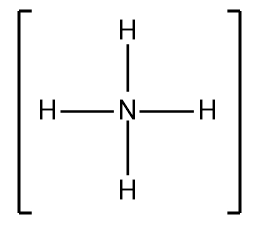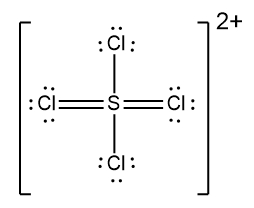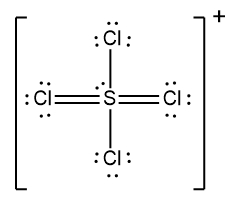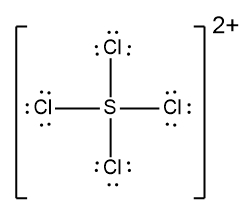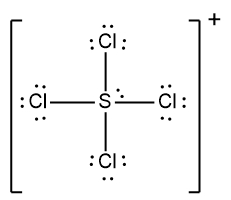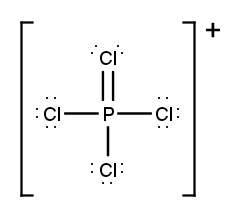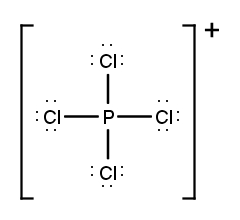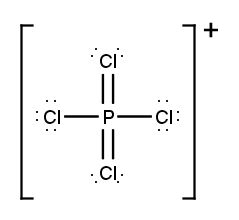In Lewis dot structures, cations have fewer valence electrons because, remember, cations are positive since they are losing electrons; anions have more valence electrons, and an anion is a negative ion because it's gaining electrons. So using this, let's answer this example question. It says draw the Lewis dot structure for the following anion, BCl4-. Alright. So here we have to determine the total number of valence electrons of the structure. And recall that valence electrons equal the group number of the element. So here we have boron, which is in group 3A, and there's one of them. We have chlorine, which is in group 7A, and there are 4 of them. That's 28. And then remember that this minus one means we've gained an electron. So we're going to add 1 electron to this mix, giving us a total of 32 valence electrons. Now, we're going to place the least electronegative element in the center and connect all elements with single bonds. We're going to follow our bonding preferences guide to determine atom connectivity. Now, if you haven't watched my video on bonding preferences, I highly suggest you go back and take a look because it helps you to identify what kind of bonds these elements like to make—2 bonds, 3 bonds, etc. So here we're going to place boron in the center, and we're going to make single bonds to each of the chlorines. Now we're going to add electrons to all surrounding elements until they have 8 electrons because we're trying to follow the octet rule. Now remember, hydrogen doesn't follow the octet rule; it follows the duet rule. It only wants 2 valence electrons around it, so that it can be just like helium. So, I'm adding enough electrons so that each chlorine is following the octet rule. Now place any remaining electrons on the central element or central atom. So we've already used all 32 of our electrons here, so there's none left. Step 5 says that we need to place the ion in brackets and its charge in the top right corner. So that's right. For ions, once you draw the Lewis dot structure, you have to put it in brackets with the charge on the outside. So brackets around it, and you'd put the minus charge here. Here I'm going to bring it down so we can see it better. So here goes boron with the 4 chlorines that it's attached to. So here go our 4 chlorines that we're attached to. Since it's an ion, put it in brackets, and the charge on the outside and top right corner. Now for cations, this is not a cation, but for cations, remove valence electrons from the central element. So just keep that in mind when dealing with cations. So these would be the rule that we use in order to draw either cations or anions when asked to determine the Lewis dot structure.
- 1. Matter and Measurements4h 29m
- What is Chemistry?5m
- The Scientific Method9m
- Classification of Matter16m
- States of Matter8m
- Physical & Chemical Changes19m
- Chemical Properties8m
- Physical Properties5m
- Intensive vs. Extensive Properties13m
- Temperature (Simplified)9m
- Scientific Notation13m
- SI Units (Simplified)5m
- Metric Prefixes24m
- Significant Figures (Simplified)11m
- Significant Figures: Precision in Measurements7m
- Significant Figures: In Calculations19m
- Conversion Factors (Simplified)15m
- Dimensional Analysis22m
- Density12m
- Specific Gravity9m
- Density of Geometric Objects19m
- Density of Non-Geometric Objects9m
- 2. Atoms and the Periodic Table5h 23m
- The Atom (Simplified)9m
- Subatomic Particles (Simplified)12m
- Isotopes17m
- Ions (Simplified)22m
- Atomic Mass (Simplified)17m
- Atomic Mass (Conceptual)12m
- Periodic Table: Element Symbols6m
- Periodic Table: Classifications11m
- Periodic Table: Group Names8m
- Periodic Table: Representative Elements & Transition Metals7m
- Periodic Table: Elemental Forms (Simplified)6m
- Periodic Table: Phases (Simplified)8m
- Law of Definite Proportions9m
- Atomic Theory9m
- Rutherford Gold Foil Experiment9m
- Wavelength and Frequency (Simplified)5m
- Electromagnetic Spectrum (Simplified)11m
- Bohr Model (Simplified)9m
- Emission Spectrum (Simplified)3m
- Electronic Structure4m
- Electronic Structure: Shells5m
- Electronic Structure: Subshells4m
- Electronic Structure: Orbitals11m
- Electronic Structure: Electron Spin3m
- Electronic Structure: Number of Electrons4m
- The Electron Configuration (Simplified)22m
- Electron Arrangements5m
- The Electron Configuration: Condensed4m
- The Electron Configuration: Exceptions (Simplified)12m
- Ions and the Octet Rule9m
- Ions and the Octet Rule (Simplified)8m
- Valence Electrons of Elements (Simplified)5m
- Lewis Dot Symbols (Simplified)7m
- Periodic Trend: Metallic Character4m
- Periodic Trend: Atomic Radius (Simplified)7m
- 3. Ionic Compounds2h 18m
- Periodic Table: Main Group Element Charges12m
- Periodic Table: Transition Metal Charges6m
- Periodic Trend: Ionic Radius (Simplified)5m
- Periodic Trend: Ranking Ionic Radii8m
- Periodic Trend: Ionization Energy (Simplified)9m
- Periodic Trend: Electron Affinity (Simplified)8m
- Ionic Bonding6m
- Naming Monoatomic Cations6m
- Naming Monoatomic Anions5m
- Polyatomic Ions25m
- Naming Ionic Compounds11m
- Writing Formula Units of Ionic Compounds7m
- Naming Ionic Hydrates6m
- Naming Acids18m
- 4. Molecular Compounds2h 18m
- Covalent Bonds6m
- Naming Binary Molecular Compounds6m
- Molecular Models4m
- Bonding Preferences6m
- Lewis Dot Structures: Neutral Compounds (Simplified)8m
- Multiple Bonds4m
- Multiple Bonds (Simplified)6m
- Lewis Dot Structures: Multiple Bonds10m
- Lewis Dot Structures: Ions (Simplified)8m
- Lewis Dot Structures: Exceptions (Simplified)12m
- Resonance Structures (Simplified)5m
- Valence Shell Electron Pair Repulsion Theory (Simplified)4m
- Electron Geometry (Simplified)8m
- Molecular Geometry (Simplified)11m
- Bond Angles (Simplified)11m
- Dipole Moment (Simplified)15m
- Molecular Polarity (Simplified)7m
- 5. Classification & Balancing of Chemical Reactions3h 17m
- Chemical Reaction: Chemical Change5m
- Law of Conservation of Mass5m
- Balancing Chemical Equations (Simplified)13m
- Solubility Rules16m
- Molecular Equations18m
- Types of Chemical Reactions12m
- Complete Ionic Equations18m
- Calculate Oxidation Numbers15m
- Redox Reactions17m
- Spontaneous Redox Reactions8m
- Balancing Redox Reactions: Acidic Solutions17m
- Balancing Redox Reactions: Basic Solutions17m
- Balancing Redox Reactions (Simplified)13m
- Galvanic Cell (Simplified)16m
- 6. Chemical Reactions & Quantities2h 35m
- 7. Energy, Rate and Equilibrium3h 46m
- Nature of Energy6m
- First Law of Thermodynamics7m
- Endothermic & Exothermic Reactions7m
- Bond Energy14m
- Thermochemical Equations12m
- Heat Capacity19m
- Thermal Equilibrium (Simplified)8m
- Hess's Law23m
- Rate of Reaction11m
- Energy Diagrams12m
- Chemical Equilibrium7m
- The Equilibrium Constant14m
- Le Chatelier's Principle23m
- Solubility Product Constant (Ksp)17m
- Spontaneous Reaction10m
- Entropy (Simplified)9m
- Gibbs Free Energy (Simplified)18m
- 8. Gases, Liquids and Solids3h 25m
- Pressure Units6m
- Kinetic Molecular Theory14m
- The Ideal Gas Law18m
- The Ideal Gas Law Derivations13m
- The Ideal Gas Law Applications6m
- Chemistry Gas Laws16m
- Chemistry Gas Laws: Combined Gas Law12m
- Standard Temperature and Pressure14m
- Dalton's Law: Partial Pressure (Simplified)13m
- Gas Stoichiometry18m
- Intermolecular Forces (Simplified)19m
- Intermolecular Forces and Physical Properties11m
- Atomic, Ionic and Molecular Solids10m
- Heating and Cooling Curves30m
- 9. Solutions4h 10m
- Solutions6m
- Solubility and Intermolecular Forces18m
- Solutions: Mass Percent6m
- Percent Concentrations10m
- Molarity18m
- Osmolarity15m
- Parts per Million (ppm)13m
- Solubility: Temperature Effect8m
- Intro to Henry's Law4m
- Henry's Law Calculations12m
- Dilutions12m
- Solution Stoichiometry14m
- Electrolytes (Simplified)13m
- Equivalents11m
- Molality15m
- The Colligative Properties15m
- Boiling Point Elevation16m
- Freezing Point Depression9m
- Osmosis16m
- Osmotic Pressure9m
- 10. Acids and Bases3h 29m
- Acid-Base Introduction11m
- Arrhenius Acid and Base6m
- Bronsted Lowry Acid and Base18m
- Acid and Base Strength17m
- Ka and Kb12m
- The pH Scale19m
- Auto-Ionization9m
- pH of Strong Acids and Bases9m
- Acid-Base Equivalents14m
- Acid-Base Reactions7m
- Gas Evolution Equations (Simplified)6m
- Ionic Salts (Simplified)23m
- Buffers25m
- Henderson-Hasselbalch Equation16m
- Strong Acid Strong Base Titrations (Simplified)10m
- 11. Nuclear Chemistry56m
- BONUS: Lab Techniques and Procedures1h 38m
- BONUS: Mathematical Operations and Functions47m
- 12. Introduction to Organic Chemistry1h 34m
- 13. Alkenes, Alkynes, and Aromatic Compounds2h 12m
- 14. Compounds with Oxygen or Sulfur1h 6m
- 15. Aldehydes and Ketones1h 1m
- 16. Carboxylic Acids and Their Derivatives1h 11m
- 17. Amines38m
- 18. Amino Acids and Proteins1h 51m
- 19. Enzymes1h 37m
- 20. Carbohydrates1h 46m
- Intro to Carbohydrates4m
- Classification of Carbohydrates4m
- Fischer Projections4m
- Enantiomers vs Diastereomers8m
- D vs L Enantiomers8m
- Cyclic Hemiacetals8m
- Intro to Haworth Projections4m
- Cyclic Structures of Monosaccharides11m
- Mutarotation4m
- Reduction of Monosaccharides10m
- Oxidation of Monosaccharides7m
- Glycosidic Linkage14m
- Disaccharides7m
- Polysaccharides7m
- 21. The Generation of Biochemical Energy2h 8m
- 22. Carbohydrate Metabolism2h 22m
- 23. Lipids2h 26m
- Intro to Lipids6m
- Fatty Acids25m
- Physical Properties of Fatty Acids6m
- Waxes4m
- Triacylglycerols12m
- Triacylglycerol Reactions: Hydrogenation8m
- Triacylglycerol Reactions: Hydrolysis13m
- Triacylglycerol Reactions: Oxidation7m
- Glycerophospholipids15m
- Sphingomyelins13m
- Steroids15m
- Cell Membranes7m
- Membrane Transport10m
- 24. Lipid Metabolism1h 45m
- 25. Protein and Amino Acid Metabolism1h 37m
- 26. Nucleic Acids and Protein Synthesis2h 54m
- Intro to Nucleic Acids4m
- Nitrogenous Bases16m
- Nucleoside and Nucleotide Formation9m
- Naming Nucleosides and Nucleotides13m
- Phosphodiester Bond Formation7m
- Primary Structure of Nucleic Acids11m
- Base Pairing10m
- DNA Double Helix6m
- Intro to DNA Replication20m
- Steps of DNA Replication11m
- Types of RNA10m
- Overview of Protein Synthesis4m
- Transcription: mRNA Synthesis9m
- Processing of pre-mRNA5m
- The Genetic Code6m
- Introduction to Translation7m
- Translation: Protein Synthesis18m
Lewis Dot Structures: Ions (Simplified) - Online Tutor, Practice Problems & Exam Prep
 Created using AI
Created using AIIn Lewis dot structures, cations have fewer valence electrons due to electron loss, while anions have more from electron gain. For the anion BCl4-, calculate total valence electrons: boron (1) + chlorine (4 x 7) + 1 (for the charge) = 32. Place boron at the center, bond it to four chlorines, and ensure each chlorine follows the octet rule. Finally, enclose the structure in brackets with the charge in the top right corner. Understanding these principles is essential for accurately representing ionic compounds.
Lewis Dot Structures of Ions involves losing or gaining valence electrons to draw the most likely structure.
Lewis Dot Structures of Ions
Lewis Dot Structures: Ions (Simplified) Concept 1
Video transcript
Draw the Lewis Dot Structure for the following cation:NH4+.
Determine the Lewis Dot Structure for the following ion:O22–.
Determine the Lewis Dot Structure for the following ion:SCl42+.
Draw the Lewis Dot Structure for the following ion:PCl4+.
Do you want more practice?
Here’s what students ask on this topic:
How do you draw the Lewis dot structure for anions?
To draw the Lewis dot structure for anions, follow these steps: First, determine the total number of valence electrons by adding the group numbers of each element and accounting for the charge (add electrons for negative charge). Place the least electronegative element in the center and connect all elements with single bonds. Add electrons to surrounding elements to satisfy the octet rule. Place any remaining electrons on the central atom. Finally, enclose the structure in brackets and indicate the charge in the top right corner.
 Created using AI
Created using AIWhat is the significance of the octet rule in Lewis dot structures?
The octet rule is significant in Lewis dot structures because it helps predict the arrangement of electrons around atoms. Atoms tend to form bonds to have eight electrons in their valence shell, achieving a stable electron configuration similar to noble gases. This rule guides the placement of electrons in bonds and lone pairs, ensuring that each atom (except hydrogen, which follows the duet rule) has a complete octet.
 Created using AI
Created using AIHow do you determine the total number of valence electrons in a polyatomic ion?
To determine the total number of valence electrons in a polyatomic ion, sum the valence electrons of each atom based on their group number in the periodic table. For anions, add extra electrons equal to the negative charge. For cations, subtract electrons equal to the positive charge. For example, in BCl4-, boron (group 3) has 3 electrons, each chlorine (group 7) has 7 electrons, and the negative charge adds 1 electron, totaling 32 valence electrons.
 Created using AI
Created using AIWhy do cations have fewer valence electrons in Lewis dot structures?
Cations have fewer valence electrons in Lewis dot structures because they lose electrons to achieve a positive charge. This loss of electrons results in fewer valence electrons around the central atom. For example, if a neutral atom loses one electron to form a cation with a +1 charge, it will have one less valence electron in its Lewis dot structure.
 Created using AI
Created using AIWhat is the process for placing the charge on a Lewis dot structure for ions?
After drawing the Lewis dot structure for an ion, enclose the entire structure in square brackets. Then, place the charge of the ion in the top right corner outside the brackets. For example, for the anion BCl4-, draw the structure, enclose it in brackets, and place the negative charge outside the brackets in the top right corner.
 Created using AI
Created using AI